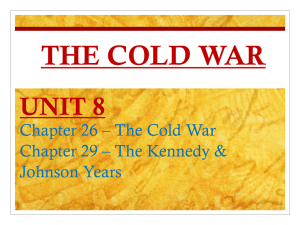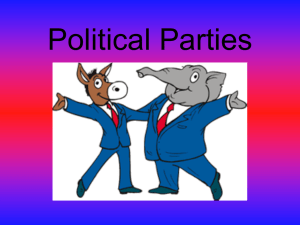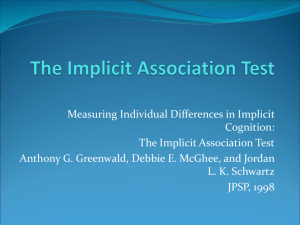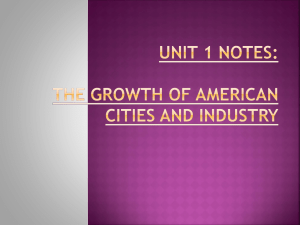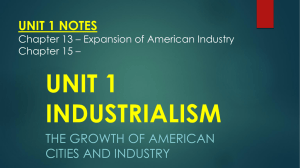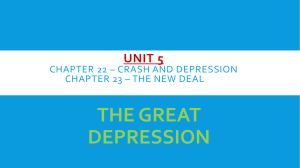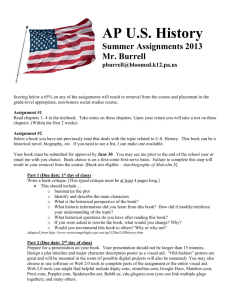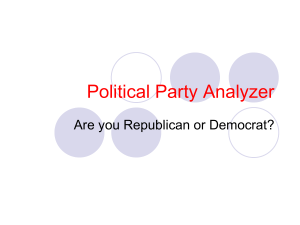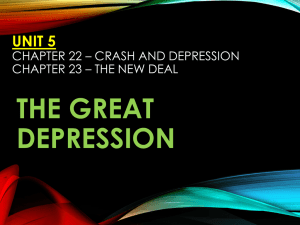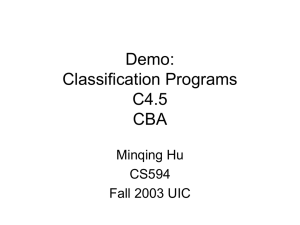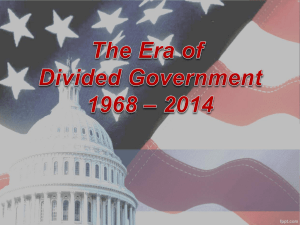THE COLD WAR
advertisement
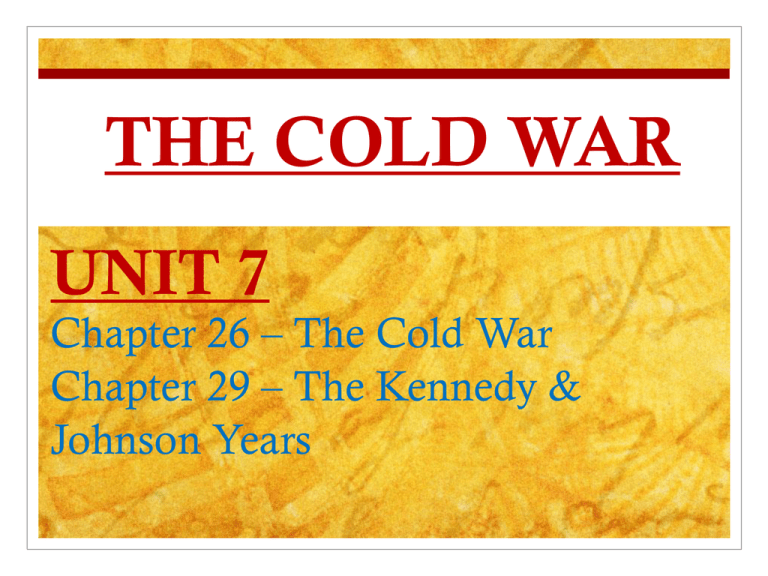
THE COLD WAR UNIT 7 Chapter 26 – The Cold War Chapter 29 – The Kennedy & Johnson Years Presidents of the United States George Washington; Federalist (1788) John Adams; Federalist (1796) Thomas Jefferson (1800) James Madison (1808) James Monroe (1816) John Quincy Adams (1824) Andrew Jackson; Democrat (1828) Martin Van Buren; Democrat (1836) William Henry Harrison; Whig (1840) John Tyler; Whig (1841) James K. Polk; Democrat (1844) Zachary Taylor; Whig (1848) Millard Fillmore; Whig (1850) Franklin Pierce; Democrat (1852) James Buchanan; Democrat (1856) Abraham Lincoln; Republican (1860) Andrew Johnson; Democrat (1865) Ulysses S. Grant; Republican (1868) Rutherford B. Hayes; Republican (1876) James Garfield; Republican (1880) #21 - … Chester A. Arthur; Republican (1881) Grover Cleveland; Democrat (1884) Benjamin Harrison; Republican (1888) Grover Cleveland; Democrat (1892) William McKinley; Republican (1896) Theodore Roosevelt; Republican (1901) William Howard Taft; Republican (1908) Woodrow Wilson; Democrat (1912) Warren G. Harding; Republican (1920) Calvin Coolidge; Republican (1923) Herbert Hoover; Republican (1928) Franklin D. Roosevelt; Democrat (1932) Harry S. Truman; Democrat (1945) Dwight D. Eisenhower; Republican (1952) John F. Kennedy; Democrat (1960) Lyndon B. Johnson; Democrat (1963) America: Pathways to the Present Chapter 26: The Cold War (1945–1960) Section 1: Origins of the Cold War Section 2: The Cold War Heats Up Section 3: The Korean War Section 4: The Continuing Cold War OBJECTIVES CORE OBJECTIVE: Analyze the origins of the Cold War and evaluate the presidential foreign policies during the Cold War. Objective 10.1: How did the differing postwar goals of the Soviet Union and the United States lead to the Cold War? Objective 10.2: How did the goals of containment influence events in the late 1940’s? Objective 10.3: Explain the Causes and effects of the Korean War. Objective 10.4: Describe characteristics of the McCarthy Era. Objective 10.5: Describe the domestic programs pursued by President Kennedy. Objective 10.6: Describe the foreign policy Cold War crises that occurred during Kennedy’s presidency. Objective 10.7: Explain the goals and effects of President Johnson’s domestic programs. THE COLD WAR HEATS UP CHAPTER 26 SECTION 2 The Marshall Plan The United States wanted to help European nations recover from the war and become economically strong democracies. The Marshall Plan was created in 1947 by U.S. Secretary of State George C. Marshall as a means to achieve these goals. It also wanted to prevent Communists from continuing to gain power in Europe. According to the Marshall Plan, participating nations would design recovery programs and would receive financial aid from the United States. Seventeen Western European nations joined the plan, receiving a total of $13 billion in aid. The Berlin Airlift As part of the postwar division of Germany, the city of Berlin, located in Communist East Germany, was divided into West Berlin (capitalist) and East Berlin (Communist). In June 1948, Stalin banned all shipments to West Berlin through East Germany, creating a blockade which threatened to cut off supplies to the city. In response, Allied nations began the Berlin airlift, which delivered thousands of tons of food and other supplies to West Berlin via air. Although the Soviet blockade ended in May 1949, Berlin remained a focal point of Cold War conflict. NATO Why create a treaty organization? Soviet vetoes prevented the United Nations from resolving a number of postwar problems. What was NATO? The North Atlantic Treaty Organization (NATO) was formed in April 1949. The United States sought to avoid the problems of post–World War I isolationism. The United States did not want to be the only nation in the Western Hemisphere committed to fighting communism. A Canadian role in the treaty organization would be vital. In joining NATO, the United States, Canada, and ten Western European nations pledged to support one another against attack, a principle known as collective security. In response, the Soviet Union created the Warsaw Pact, a military alliance between the Soviet Union and its satellite nations. Communist Advances The Soviet Atomic Threat In September 1949, Truman announced that the Soviet Union had successfully tested an atomic bomb. In response, the United States began developing the even more powerful hydrogen bomb, reestablishing itself as the world’s leading nuclear power. The newly formed Federal Civil Defense Administration distributed information on how to survive a nuclear attack; this information was ridiculed by experts. China Falls to the Communists During World War II, competing factions in China had cooperated, but fighting between them resumed towards the end of the war. At first, the United States supported Nationalist leader Jiang Jieshi against Communist Mao Zedong. However, the United States later decided to focus on Western Europe instead. Many Americans viewed Mao Zedong’s creation of a Communist state in China as a failure of Truman’s policies. The Cold War at Home During the late 1940s, fear of Communist spies created a climate of suspicion in the United States. The House Un-American Activities Committee (HUAC) began investigating Hollywood personalities who the committee claimed, had Communist leanings. Truman established a federal employee loyalty program in 1947, checking the backgrounds of all new and existing federal employees. When one group, known as the Hollywood Ten, refused to answer HUAC’s questions, they were cited for contempt of Congress and imprisoned. Hollywood studios compiled a blacklist, a list circulated to employers naming persons who should not be hired. Blacklisted individuals came from all sections of the industry and included anyone who seemed subversive. The Cold War at Home Fueled by fears of disloyal immigrants from Communist countries, the 1952 McCarran-Walter Act reestablished the immigration quota system from 1924. This act discriminated against potential immigrants from Asia and Southern and Central Europe. Two famous spy cases reinforced fears that Soviet spies in the United States were sharing American secrets with foreign Communists. These were the cases of Alger Hiss and of Julius and Ethel Rosenberg. Alger Hiss was a former government employee sent to prison for four years for lying to a federal grand jury on espionage. (1950) The Rosenbergs were executed for being communist spies in 1953 The Cold War Heats Up— Assessment Which of these phrases best describes NATO? (A) A collective security pact between the United States, Canada, and Western European nations (B) A military alliance between the USSR and its satellite nations (C) A U.S.-sponsored program for postwar recovery (D) A regional group within the United Nations Which of these was a result of HUAC’s investigation of the movie industry? (A) Hollywood approved many scripts that dealt with controversial social problems. (B) Many Hollywood personalities were blacklisted. (C) The McCarran-Walter Act was passed. (D) Pro-Soviet movies became popular. The Cold War Heats Up— Assessment Which of these phrases best describes NATO? (A) A collective security pact between the United States, Canada, and Western European nations (B) A military alliance between the USSR and its satellite nations (C) A U.S.-sponsored program for postwar recovery (D) A regional group within the United Nations Which of these was a result of HUAC’s investigation of the movie industry? (A) Hollywood approved many scripts that dealt with controversial social problems. (B) Many Hollywood personalities were blacklisted. (C) The McCarran-Walter Act was passed. (D) Pro-Soviet movies became popular.
